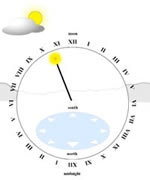
Relativity Myths & Ideas

Myths
Absolute Space
It is widely held that Newtonian mechanics requires an absolute space, and that Einstein's Special Theory of Relativity did away with that need, There are two reasons why this myth may have arisen:
- When Sir Isaac Newton defined the laws of mechanics, he considered space to be absolute.
- At the time that Einstein formulated his theory, it was generally held that there was an absolute state of rest, which was defined by the luminiferous aether (or ether).
However, it does not follow from these that Newtonian mechanics requires an absolute space. The concept of relativity was originated by Galileo a few hundred years before Einstein. At that time it was known as Galilean Invariance. Newtonian mechanics is, and always was, wholly compatible with Galilean Invariance, and the combination of them is known as Newtonian Relativity.

Time
There is a myth that time is equivalent to a fourth spatial dimension. However, it is very easily shown to be false, because a spacetime interval is proportional to the difference between the spatial distance and the time interval between the events. So, although it is true that time intervals and spatial distances combine in spacetime, a time interval has the opposite effect on spacetime from a spatial distance.
The mathematical relationship is explained in appendix B of the primer, but here it is sufficient to note that time is most definitely not equivalent to a spatial dimension.
The Speed of Light

The idea that the speed of light, in empty space, is the same in all frames of reference is mainstream physics. It is fundamental to Albert Einstein's Special and General Theories of Relativity. So could it really be a myth? Well, perhaps.
The reason why this might be a myth is that it is only indirectly supported by the evidence. Now it is perfectly legitimate say that the success of Einstein's theory implies that the speed of light is constant in all frames of reference, but that is not the same as saying that it has been shown to be the case. To be shown to be the case, it would have to follow from the evidence supporting the theory, which it does not. Indeed Einstein never claimed that it does.
The evidence from experiments like the Michelson-Morley experiment only show that the speed of light is constant in the rest frame of the equipment used to measure it. In other words, it may be deduced that the speed of light is constant with respect to the object that the light is approaching. That says nothing about the speed that the light is travelling at with respect to other objects in different rest frames.

Clocks and Proper Time
It is said that clocks tell proper time, but what is proper time, and do clocks tell it? Well, proper time is the name given to the interval between two events that is recorded by a clock that is co-located with the events. This interval can be interpreted in two ways:
- Under special relativity, the proper time interval between events is unique, and correlates to the coordinate time elapsed in the frame of reference in which the events are co-located.
- Under general relativity the proper time interval depends upon the path through spacetime taken by the clock between the two events. There are many paths that can taken, therefore the proper time interval is not unique. However, the proper time that a clock would display in taking a specific path is also the coordinate time that an observer would experience in following that path between the events.
Furthermore, a clock will tell the coordinate time interval that elapses between any two events, when viewed from its rest frame, irrespective of whether the events are co-located. Hence proper time is a subset of coordinate time. So it is more accurate to say that clocks tell coordinate time, which equates to the proper time for co-located events.

Time Dilation, Distance Contraction and Simultaneity
Under Einstein's Special Theory of Relativity, time dilation and distance contraction are phenomena that are inferred from the Lorentz transformation, and are mathematically interchangeable. As a result of this, many examples, as in this one, assume that what, from one rest frame is regarded as time dilation, can, from another, be regarded as distance contraction. However, it seems logical that:
- If time dilation occurs, then less time passes for the traveller when travelling a given distance at a specific velocity, without the distance contracting (correlating to the Lorentz transformation for time). Or...
- If distance contraction occurs, then there is less distance to travel, so it will take less time, without time dilating (correlating to the Lorentz transformation for distance). Furthermore, without time dilation, differences in simultanity will not, and cannot, arise.
So in both cases less time passes, but for very different reasons. Hence we may, arguably, regard time dilation and distance contraction as mutually exclusive alternative interpretations, rather like there are a number of mutually exclusive interpretations of quantum mechanics, all of which are based on the same mathematical relationships and the same empirical evidence.
But hasn't time dilation been proven beyond doubt? No. It has been shown that differences in the passage of time can, and do, arise. It has not been shown whether this is due to time dilation or distance contraction, nor whether it is appropriate to treat these phenomena as interchangeable.

Relative Motion
There is a myth that the theory of relativity is based on the idea that "all motion is relative". If so, it would be equally valid to say that the Sun revolves around the Earth, as saying that the Earth revolves around the Sun. That is incorrect for the following reasons:
- The idea that "all motion is relative" is much older than Einstein's theory of relativity. Indeed, it was described by Galileo Galilei, as we discuss here. His insight, together with Newton's Laws of Motion, form Newtonian Relativity, which we discuss here.
- Einsteins original theory of relativity, which is known as the Special Theory, is not based on the idea that "all motion is relative". Instead, it is based on two different postulates, which we discuss here.
- It is true to say that, under both Newtonian relativity and the Special Theory, all motion that is at a uniform constant velocity is equal. These are known as inertial frames. However, motion under linear or rotational acceleration is not inertial and hence is not relative.
With that in mind, let's investigate the effects of taking the Earth, the Sun and the Milky Way as our reference:
- Taking the EarthE as our reference, not only the Sun, but the whole universe appears to revolve around the Earth on a daily basis.
- Taking the SunS as our reference, the universe, again, is spinning round, because the Sun rotates on its axis once every 25 (Earth) days.
- Taking the Milky WayG (our local galaxy) as our reference, the universe is stationary with the Sun revolving on its axis every 25 days, and the Earth revolving around the Sun once every 365 days.
So two of the views have the whole universe spinning around the Sun or the Earth. How credible is it that either of them is actually the centre of our galaxy, let alone the whole universe? Not very likely. But is that conclusive? The arguments to the contrary are:
- Mathematically, the choice of rest frame from which motion is deemed to take place is purely arbitrary. It can be chosen at will, to simplify the calculations.
- Under Einstein's General Theory the principle of co-variance says that, in principle, all systems of coordinates are "equally suitable for the description of nature".
However mathematical convenience is not concerned with what is actually taking place. And the General Theory also says that the gravitational field "defines the metrical properties of the space". Hence according to the General Theory, the Earth is revolving around the gravitational centre of the Solar System. Furthermore, as the Sun is at, or near, the gravitational centre of the Solar System, it is true to say that "the Earth revolves around the Sun", and not vice versa.
Hence according to the General Theory, the Earth is revolving around the gravitational centre of the Solar System. Furthermore, as the Sun is at, or near, the gravitational centre of the Solar System, it is true to say that "the Earth revolves around the Sun", and not vice versa.
